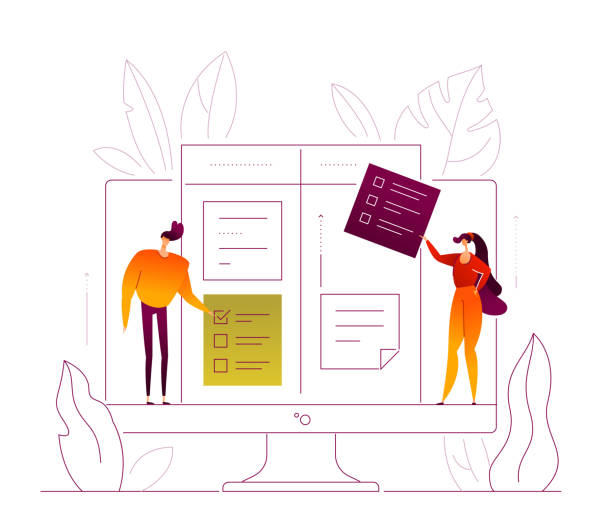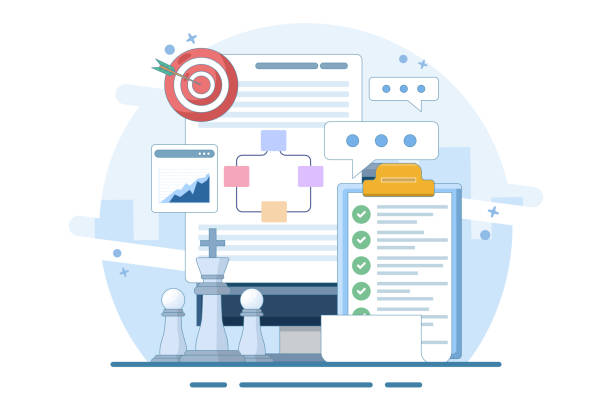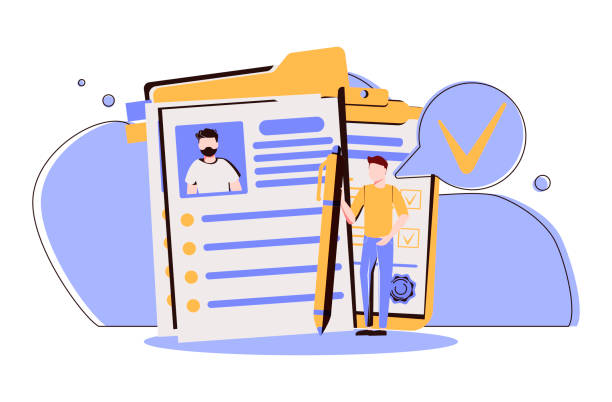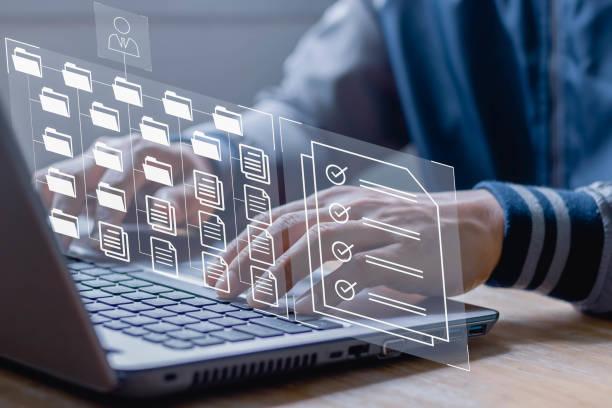Introduction to the Importance of Website Security

In today’s digital world, where online interactions have become an inseparable part of daily life, #WebsiteSecurity and data protection are of vital importance.
Undoubtedly, one of the most significant concerns for businesses and users is ensuring the safety of personal and financial information in the virtual space.
Neglecting secure website design can lead to catastrophic consequences; loss of sensitive data, damage to brand reputation, and even heavy financial losses are just some of these risks.
Imagine a website intended to be a secure place for information exchange, suddenly becoming the target of #CyberAttacks and #UserData falling into the hands of malicious individuals.
This scenario is every online business’s nightmare and demonstrates why secure website design is no longer an option, but an absolute necessity.
Web security is not just about preventing attacks; it also includes building trust and confidence among users.
Insecure websites are not only vulnerable to intrusion but also provide an unpleasant user experience and can lead to customer loss.
Any negligence in this area can jeopardize the future of a business.
In this comprehensive article, we will explore various dimensions of secure site design and provide practical solutions to enhance the security of online platforms, so that both users and business owners can operate with peace of mind in the web space.
Our goal is to make you aware of the importance of this topic by providing explanatory and somewhat thought-provoking content, and to pave the way for building a website resilient to cyber threats.
This proactive approach is the foundation of any successful online platform.
Are you dissatisfied with the low sales of your e-commerce site?
Rasaweb is your solution for having a professional and high-selling e-commerce site.
✅ Significant increase in sales and revenue
✅ Easy and enjoyable shopping experience for customers
⚡ Get a free consultation from Rasaweb now!
Basic Principles of Secure Website Design from a Technical Perspective

To achieve secure website design, understanding technical principles and implementing them correctly is of paramount importance.
The first step in this path is the use of secure communication protocols such as #SSL_TLS.
These protocols prevent eavesdropping and data manipulation by encrypting data transmitted between the user’s browser and the website server.
The presence of a valid SSL certificate not only enhances security but also plays a significant role in SEO and increasing user trust.
The second vital principle is applying regular updates.
Software used on the website, from the server operating system to the CMS and plugins, must always be updated to their latest versions.
Many cyberattacks occur through known vulnerabilities in older software versions.
Proper implementation of #DataEncryption, especially for sensitive user information such as passwords and financial data, is crucial.
This includes using strong hashing algorithms for passwords and encrypting data in the database.
Additionally, secure server configuration and the use of a #Firewall to filter malicious traffic and prevent unauthorized access are essential.
Secure coding principles, such as input validation to prevent attacks like SQL Injection and XSS, must be considered from the beginning of the development process.
A secure web development starts from the initial stages of system architecture design and continues throughout the software lifecycle.
This specialized and instructive approach provides a strong foundation for any website seeking long-term stability and security.
Countering Common Web Security Threats

In the path of secure website design, identifying and countering common security threats is of great importance.
One of the most prevalent attacks is #SQL_Injection, where an attacker injects malicious SQL code into website inputs, attempting to access or modify database information.
To counter this threat, using Prepared Statements or ORMs and thorough Input Validation are essential.
Another threat is #XSS (Cross-Site Scripting), which allows an attacker to execute malicious scripts in the victim user’s browser.
To prevent XSS, all user input data must be filtered and encoded before being displayed in the output.
#CSRF (Cross-Site Request Forgery) is also a type of attack where the attacker tricks the user into sending an unintended request to the website without their knowledge.
Using CSRF tokens and checking the SameSite cookie attribute can be effective in countering it.
#DDoS (Distributed Denial of Service) attacks are also carried out with the aim of disabling the website by sending a huge volume of traffic to the server.
To counter DDoS, the use of DDoS protection services and proper firewall configuration are recommended.
Furthermore, attention should be paid to #WebSecurity at various layers.
| Threat Type | Brief Description | Primary Prevention Methods |
|---|---|---|
| SQL Injection | Injecting malicious SQL code to access the database | Prepared Statements, ORM, Input Validation |
| Cross-Site Scripting (XSS) | Injecting malicious scripts into the user’s browser | Encoding outputs, thorough Input Validation |
| Cross-Site Request Forgery (CSRF) | Tricking the user into performing unintended operations | CSRF tokens, SameSite cookies |
| DDoS (Distributed Denial of Service) | Disabling service by sending high traffic | DDoS protection services, WAF |
Given the increasing complexity of threats, a secure website design requires a multi-layered approach.
Development teams must continuously educate themselves about new vulnerabilities and implement best practices in their coding.
This proactive and planned approach is an integral part of any successful website security project and assures users that their information is in a protected environment.
Specialized content and detailed guidance in this area are crucial for any developer aiming to build a secure site.
The Role of Platform and Hosting Selection in Site Security

Proper selection of the platform and #SecureHosting provider forms the backbone of a secure website design.
At the beginning of any web project, the decision to use a #SecureCMS (such as WordPress, Joomla, Drupal) or develop a custom system should be made with security aspects in mind.
Popular CMSs, while user-friendly, are also prime targets for hackers due to their widespread use.
Therefore, regular updates of the core, plugins, and themes are crucial for them.
On the other hand, website hosting also plays a key role in overall security.
The choice between shared hosting, VPS (Virtual Private Server), and dedicated server should be based on anticipated traffic, data sensitivity, and budget.
Shared hosting is cheaper but its security might be affected by other sites on the same server.
VPS and dedicated servers offer more control over #ServerConfiguration and security.
A reliable hosting provider should offer strong security measures such as advanced firewalls, intrusion detection systems (IDS), regular backups, and 24-hour monitoring.
Using a CDN (Content Delivery Network) can also enhance website security by distributing traffic and protecting against DDoS attacks, in addition to increasing speed.
#ServerConfiguration should be such that it provides minimal necessary access and disables unnecessary services.
All these considerations show that secure website design is a comprehensive process that begins from the infrastructure selection stage, and with an explanatory and guiding approach, the best choices can be made.
Do you know that a weak corporate website loses you many opportunities daily? Solve this problem forever with professional corporate website design by Rasaweb!
✅ Create a powerful and reliable image for your brand
✅ Attract new customers purposefully and increase sales
⚡ [Get free website design consultation]
Strong Password and Authentication Management

One of the main vulnerabilities in many websites is weak password management and authentication systems.
To achieve a secure website design, implementing #StrongAuthentication is of high importance.
This begins with enforcing strict password policies: users should be forced to choose complex passwords containing uppercase and lowercase letters, numbers, and special characters, and avoid common and guessable passwords.
Additionally, the system should require users to periodically change their passwords.
From a technical perspective, secure storage of user passwords in the database is crucial.
Passwords should never be stored in plaintext; instead, they should be hashed using strong hashing algorithms and with a “salt” (a unique random string).
“Salting” prevents “Rainbow Table” attacks, and even if a hacker gains access to the database, passwords will not be easily reversible.
#TwoFactorAuthentication (MFA) provides an additional layer of security.
This method requires the user to provide a second factor (such as a code sent to their mobile phone or a fingerprint) in addition to their password to verify their identity.
Proper MFA implementation significantly reduces the risk of unauthorized access.
Also, session management should be done carefully; secure and expiring session tokens should be used, and sessions should be immediately invalidated after user logout or prolonged inactivity.
For a secure website, educating users about the importance of strong passwords and using MFA is also part of the comprehensive security strategy.
This educational and specialized approach helps strengthen overall #WebSecurity.
Security and Privacy Policies in Website Design

Beyond technical aspects, secure site design also involves developing and adhering to #InformationSecurityPolicy and #Privacy.
In the digital age, users are increasingly concerned about how their personal information is collected, stored, and used.
Compliance with international laws and regulations such as #GDPR (General Data Protection Regulation) in Europe or CCPA in California, is essential for websites dealing with global users.
Even if you are not subject to these laws, implementing their principles can help build user trust.
A clear and understandable #PrivacyPolicy should explicitly explain what information is collected from users, how it is used, with whom it is shared, and how it is protected.
This policy should be easily accessible to users, and explicit consent should be obtained from them for the collection of sensitive information.
Furthermore, the management of #Cookies and other tracking tools should be handled carefully.
Users should have the option to refuse or accept cookies, especially those not essential for site functionality.
Information security must be maintained at every stage of the data lifecycle, from collection to deletion.
This includes using encryption for data in transit and data at rest, as well as strict access controls to databases.
An analytical and explanatory approach in this area shows that building a secure site is not just about protecting against external attacks, but also about accountability and transparency towards users.
These principles not only help with legal compliance but also increase user trust and loyalty.
Website Security Review and Testing

Secure website design is not a one-time process; it requires #PeriodicReview and continuous security tests to ensure its resilience against new threats.
One of the most effective methods is #PenetrationTesting.
In this process, cybersecurity specialists (ethical hackers) attempt to discover system vulnerabilities by simulating real attacks.
The results of these tests help the development team fix security weaknesses before they are discovered by real attackers.
Using an automated #SecurityScanner can also be useful in identifying known vulnerabilities such as SQL injection or XSS.
These tools can regularly scan the website and provide reports on potential issues.
In addition to technical tests, security #AcceptanceTesting should also be performed.
These tests ensure that the security requirements defined at the beginning of the project are correctly implemented and that the system operates according to security standards.
Bug Bounty programs can also be a fun yet very effective way to find vulnerabilities.
In these programs, security researchers (white-hat hackers) are rewarded for finding and reporting vulnerabilities in the system.
This approach can be particularly beneficial for large organizations.
All these methods help ensure #WebSecurity over time.
| Test Method | Main Objective | Execution Time/Frequency |
|---|---|---|
| Penetration Testing | Simulating attacks to discover complex vulnerabilities | Annually or after major changes |
| Vulnerability Scanning | Identifying known and common vulnerabilities | Weekly or monthly |
| Code Review | Reviewing source code to find security flaws | During development and after every significant change |
| Bug Bounty Programs | Encouraging researchers to find and report vulnerabilities | Continuous |
By combining these methods, a comprehensive #SecurityProtocol can be created, ensuring that secure site building is an ongoing and dynamic process.
This specialized and guiding process is essential for any organization seeking to maintain the integrity and availability of its website.
Responding to Security Incidents and Data Recovery

Even with the best secure website design and implementation of the strongest preventive measures, the possibility of a security incident still exists.
No matter how strong your security measures are, no system is 100% impenetrable.
For this reason, having an #IncidentResponsePlan and a #DisasterRecovery strategy is essential for any website.
This plan should include specific steps for identification, containment, eradication, recovery, and lessons learned.
The first step after detecting an intrusion is to cut off the attacker’s access and limit the scope of damage to prevent its spread to other sections or systems.
Then, the source of the intrusion must be identified and eradicated, whether this eradication involves malware removal, patching vulnerabilities, or changing passwords.
The #DisasterRecovery phase involves restoring systems and data to their normal state prior to the incident.
This is where the importance of #Backup, regular and reliable, becomes evident.
Backups must be stored securely and in separate locations and have the capability for quick restoration.
Furthermore, after each incident, a thorough Forensic Analysis should be conducted to determine the root cause of the intrusion and learn necessary lessons to prevent its recurrence.
This informational and guiding process helps organizations not only prevent future damage but also enhance their readiness to confront subsequent security challenges.
A secure site building also requires readiness for the worst-case scenarios, and this readiness is an important part of a comprehensive #SecurityProtocol.
Does your current corporate website present a worthy image of your brand and attract new customers?
If not, transform this challenge into an opportunity with Rasaweb’s professional corporate website design services.
✅ Significantly improves your brand’s credibility and image.
✅ Paves the way for attracting new leads and customers.
⚡ For a free and specialized consultation, contact Rasaweb now!
The Future of Web Security and Emerging Trends

The world of web security is constantly evolving, and to maintain a secure website design, one must be familiar with #FutureTrends and emerging technologies.
One of the most important of these trends is the increasing role of #AISecurity and machine learning in identifying and countering cyber threats.
AI can detect anomalous traffic patterns, predict DDoS attacks, and even automatically react to some intrusions.
However, at the same time, AI itself can become the target of new attacks.
#BlockchainWeb and distributed ledger technologies (DLT) also have great potential to enhance web security.
Blockchain can be used for decentralized authentication systems, digital identity management, and even DNS security, which in turn helps increase transparency and resistance to manipulation.
Also, the emergence of new architectures like Microservices and Serverless brings their own unique security challenges.
While these architectures offer high flexibility, managing security in distributed environments with multiple functions has its own complexities.
The expansion of #IoT (Internet of Things) also means that websites must be prepared to manage and process input data from billions of connected devices, which creates new layers of security concerns.
An analytical and even entertaining approach to these trends can help us better understand how the future of #WebSecurity is shaping up.
To maintain online security, developers and security professionals must continuously update their knowledge and be ready to adopt and implement new technologies.
Conclusion and Final Recommendations for Web Designers

In this comprehensive article, we discussed various aspects of secure website design and emphasized its fundamental importance in today’s digital world.
From basic technical principles like SSL/TLS and secure coding to countering common threats such as SQL Injection and XSS, as well as the role of platform and hosting selection in ensuring #WebSecurity.
We saw how proper password management and strong authentication, along with clear security and privacy policies, form the main pillars of secure site building.
We also stressed the importance of continuous security testing and readiness to respond to potential incidents, and took a look at the future of web security and emerging trends.
As a final #SecurityRecommendation for web designers and developers:
Firstly, consider security from the outset (Security by Design).
Security should not be an add-on or an afterthought, but rather integrated into all aspects of the project from the very initial stages of planning and system architecture design.
Secondly, prioritize #ContinuousLearning for yourself and your team.
Cyber threats are constantly changing and evolving, so it’s necessary to keep your knowledge up-to-date regarding the latest vulnerabilities and defensive best practices.
Thirdly, cultivate a strong #SecurityCulture within your organization.
Web security is not solely the #DesignerResponsibility or the security team’s; all team members, from developers to project managers, must be aware of the importance of security and adhere to its principles.
Fourthly, use reputable security tools and services.
Web Application Firewalls (WAFs), vulnerability scanners, and penetration testing services can significantly enhance your website’s security level.
Finally, remember that maintaining online security is an ongoing process.
By following and implementing these guiding recommendations, you can build websites that not only perform excellently but are also resilient against cyber threats and gain user trust.
This comprehensive approach is the best way to ensure long-term success.
Frequently Asked Questions
| Row | Question | Answer |
|---|---|---|
| 1 | What is secure website design? | Secure website design is a process in which websites are built with security measures in mind from the early stages of development to protect them against cyberattacks, unauthorized access, and information loss. |
| 2 | Why is secure website design important? | Site security is crucial for maintaining user trust, protecting sensitive information (personal and financial), preventing damage to brand reputation, and complying with privacy and security regulations (such as GDPR). Security breaches can lead to financial and legal damages. |
| 3 | What are the most common cyberattacks a website faces? | Some of the most common attacks include SQL Injection, Cross-Site Scripting (XSS), Distributed Denial of Service (DDoS), Brute Force, and authentication information-based attacks (Credential Stuffing). |
| 4 | What is SQL Injection and how can it be prevented? | SQL Injection is a type of attack where the attacker injects malicious SQL code into site inputs, attempting to manipulate the database or extract information. To prevent it, you should use Prepared Statements/Parameterized Queries, ORM (Object-Relational Mapping), and thorough input validation. |
| 5 | What is Cross-Site Scripting (XSS)? | XSS is a type of attack where the attacker injects malicious scripts (usually JavaScript) into web pages, which are then executed by other users’ browsers. This can lead to the theft of cookies, session information, or alteration of the website’s appearance. |
| 6 | How can Brute Force attacks on login pages be prevented? | To prevent Brute Force attacks, you should use CAPTCHA, limit the number of failed login attempts (Account Lockout), two-factor authentication (2FA), and use complex and long passwords. |
| 7 | What is the role of HTTPS in website security? | HTTPS uses SSL/TLS to encrypt the communication between the user’s browser and the website server. This prevents eavesdropping, tampering, or forging of information during transmission and increases user trust. |
| 8 | What is the importance of Input Validation in security? | Input Validation is the process of checking and sanitizing data entered by the user. This prevents the injection of malicious code, XSS attacks, SQL Injection, and other vulnerabilities, ensuring that data conforms to the expected format. |
| 9 | Why is regular updating of website systems and software essential? | Regular updates of the operating system, CMS (like WordPress), plugins, themes, and libraries used address known security vulnerabilities. Hackers often exploit weaknesses in outdated software to gain unauthorized access. |
| 10 | What role does regular backup play in secure website design? | Regular and tested backups of website information (database and files) are a vital layer of defense against data loss due to cyberattacks, human error, or hardware failure. This allows for quick restoration of the website in case of a disaster. |
And other services of Rasaweb Advertising Agency in the field of advertising:
Smart Sales Automation: Designed for businesses seeking to analyze customer behavior through SEO-driven content strategy.
Smart Google Ads: A professional solution for user engagement focusing on optimizing key pages.
Smart Digital Branding: An exclusive service for increasing user engagement based on precise audience targeting.
Smart Digital Branding: Designed for businesses seeking to manage campaigns through key page optimization.
Smart Customer Journey Map: A fast and efficient solution for campaign management focusing on custom programming.
And over a hundred other services in the field of internet advertising, advertising consulting, and organizational solutions.
Internet Advertising | Advertising Strategy | Advertorials
Sources
Comprehensive Website Security ChecklistComprehensive Website Security GuideWebsite Security and User Privacy ProtectionAbout Protecting User Information in Cyberspace
? Rasaweb Afarin Digital Marketing Agency, by providing comprehensive and innovative services, from fast website design to complex SEO strategies, paves the way for your business’s success in the online space.
📍 Tehran, Mirdamad Street, next to Central Bank, Southern Kazeroun Alley, Ramin Alley, No. 6




